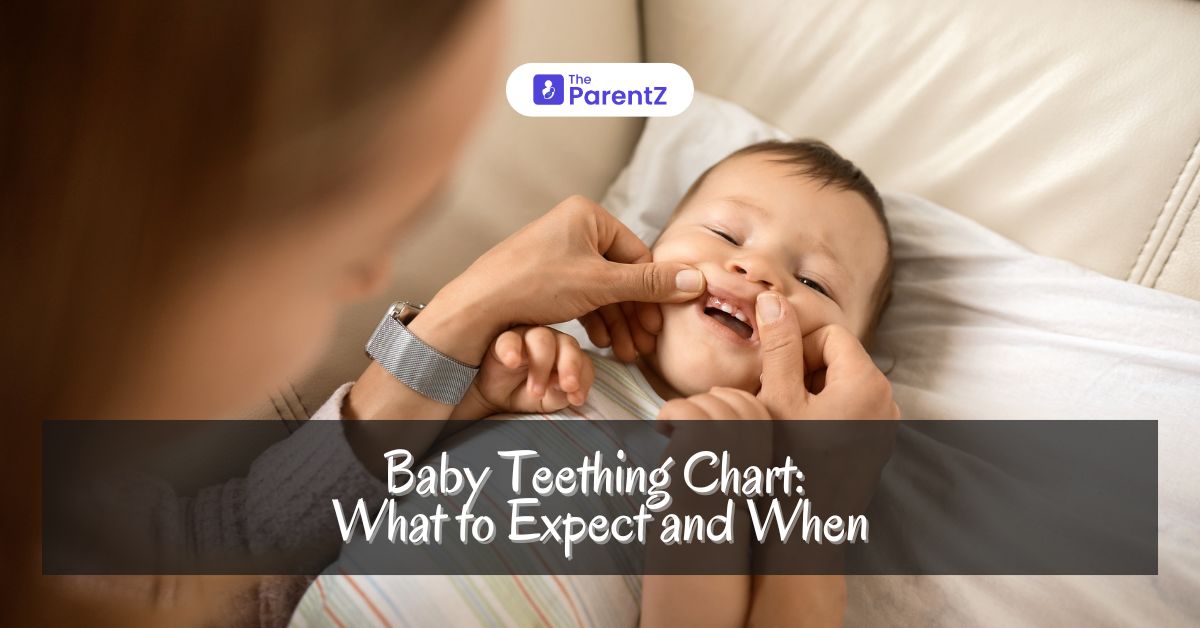Teething is a significant milestone in a baby’s development, often accompanied by a mix of excitement and discomfort. Understanding the teething process, including when to expect the appearance of each tooth and how to manage teething symptoms, can help parents navigate this phase more smoothly. This article provides a detailed guide to baby teething, including a teething chart, symptoms, and tips for soothing a teething baby.
Introduction to Baby Teething
Teething refers to the process by which a baby’s first teeth, or primary teeth, emerge through the gums. This process can start as early as three months, but the first tooth usually appears between six and ten months. By the age of three, most children have a full set of 20 primary teeth. Each baby is unique, so there can be considerable variation in the timing and order of tooth eruption.
Baby Teething Chart
Understanding the typical timeline for tooth eruption can help you anticipate and prepare for your baby’s teething milestones. Below is a general teething chart:
| Tooth Type | Eruption Age (Months) | Order of Appearance |
| Lower Central Incisors | 6-10 | First (bottom front) |
| Upper Central Incisors | 8-12 | Second (top front) |
| Upper Lateral Incisors | 9-13 | Third (top sides) |
| Lower Lateral Incisors | 10-16 | Fourth (bottom sides) |
| Upper First Molars | 13-19 | Fifth (top back) |
| Lower First Molars | 14-18 | Sixth (bottom back) |
| Upper Canines (Cuspids) | 16-22 | Seventh (top sides) |
| Lower Canines (Cuspids) | 17-23 | Eighth (bottom sides) |
| Lower Second Molars | 23-31 | Ninth (bottom back) |
| Upper Second Molars | 25-33 | Tenth (top back) |
Common Teething Symptoms
Teething can be an uncomfortable process for babies, and it often comes with various symptoms. Here are some common signs that your baby might be teething:
- Drooling: Increased saliva production is a common sign of teething.
- Chewing and Biting: Babies tend to chew on objects to relieve gum pressure.
- Irritability: Teething can cause fussiness and crankiness due to discomfort.
- Gum Swelling and Sensitivity: Gums may appear red and swollen where teeth are emerging.
- Sleep Disturbances: Teething pain can disrupt your baby’s sleep patterns.
- Refusal to Eat: Sore gums might make it uncomfortable for your baby to eat.
- Rash: Excessive drooling can cause a mild rash around the mouth and chin.
Managing Teething Discomfort
While teething is a natural process, it can cause significant discomfort for your baby. Here are some strategies to help manage and soothe teething pain:
1. Teething Toys and Rings
Description: Teething toys and rings are designed for babies to chew on, providing relief from gum discomfort.
Tips:
- Choose BPA-free, phthalate-free toys.
- Chill teething rings in the refrigerator for added relief, but avoid freezing them as this can cause gum damage.
2. Cold Compress
Description: Applying something cold to your baby’s gums can help numb the pain and reduce inflammation.
Tips:
- Use a clean, cold washcloth or chilled spoon.
- Ensure the compress is not too cold to prevent discomfort.
3. Gentle Gum Massage
Description: Massaging your baby’s gums can provide immediate relief from teething pain.
Tips:
- Wash your hands thoroughly before massaging.
- Use gentle, circular motions with your finger to massage the gums.
4. Teething Biscuits
Description: Teething biscuits are designed to be gnawed on and can help soothe sore gums.
Tips:
- Ensure the biscuits are suitable for your baby’s age and development stage.
- Always supervise your baby while they are eating to prevent choking.
5. Over-the-Counter Remedies
Description: Teething gels and pain relief medications can be used to manage severe discomfort.
Tips:
- Consult your pediatrician before using any medication.
- Follow dosage instructions carefully to avoid overuse.
Tips for Teething Care
1. Maintain Oral Hygiene
Description: Start caring for your baby’s teeth and gums early to prevent dental issues.
Tips:
- Wipe your baby’s gums with a clean, damp cloth after feedings.
- Once teeth appear, brush them gently with a soft, infant toothbrush and water.
2. Keep Baby Dry
Description: Excessive drooling can cause skin irritation and rash around your baby’s mouth.
Tips:
- Use a bib to keep your baby’s chin and neck dry.
- Apply a gentle, baby-safe moisturizer to protect the skin.
3. Monitor for Fever
Description: While mild fever can accompany teething, high fever is not typical and may indicate an infection.
Tips:
- If your baby develops a high fever or other concerning symptoms, consult your pediatrician.
4. Maintain a Regular Sleep Routine
Description: Teething can disrupt your baby’s sleep, but maintaining a routine can help minimize disturbances.
Tips:
- Stick to a consistent bedtime routine to provide comfort and security.
- Offer extra comfort and soothing techniques during nighttime wakings.
When to See a Doctor
While teething is usually manageable at home, certain symptoms warrant a visit to the doctor:
- High Fever: Persistent fever over 100.4°F (38°C) should be evaluated by a doctor.
- Severe Irritability: If your baby is inconsolable despite teething remedies.
- Signs of Infection: Swelling, pus, or bleeding from the gums.
- Feeding Problems: Persistent refusal to eat or drink, leading to dehydration.
Conclusion
Teething is a natural part of your baby’s development, but it can be a challenging time for both parents and babies. By understanding the typical timeline and symptoms of teething, you can be better prepared to provide relief and care for your little one. Remember, each baby is unique, and their teething experience may vary. If you have any concerns or questions, don’t hesitate to reach out to your pediatrician for guidance and support. With the right strategies and a bit of patience, you can help your baby navigate through this milestone with greater comfort and ease








Be the first one to comment on this story.